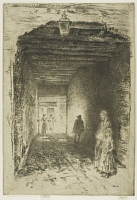The Beggars | ||
| Number: | 190 | |
| Date: | 1879/1880 | |
| Medium: | etching and drypoint | |
| Size: | 307 x 212 mm | |
| Signed: | butterfly at upper left (1-3); replaced with new butterfly (4); redrawn (5-6); removed (8) | |
| Inscribed: | no | |
| Set/Publication: | 'First Venice Set', 1880 | |
| No. of States: | 17 | |
| Known impressions: | 57 | |
| Catalogues: | K.194; M.191; W.159 | |
| Impressions taken from this plate (57) | ||
PUBLICATION
EXHIBITIONS
When Whistler was deciding on the exact content of the first Venice Set, he made a pen sketch, Venice etchings m0837, showing how they might be arranged. A first row contained The Little Venice 238 , The Two Doorways 221, The Little Lagoon 216, Traghetto 231, The Piazzetta 218, The Venetian Mast 219, and The Palaces 223. The next had The Riva 229, The Beggars, San Biagio 237, The Doorway 193 and Nocturne 222. All these were included in the first 'Venice Set' except San Biagio, for which he substituted The Little Mast. Thus in this arrangement, two large upright compositions, The Beggars and The Doorway, framed a lighter, large horizontal scene, San Biagio, and this trio were framed between two distant views of Venice, one by day (The Riva, No. 1) and one by night (Nocturne).
37: London FAS 1880 (cat. no. 3). See REFERENCES: EXHIBITIONS.
38: 'Mr. Whistler's Etchings,' The Globe, London, 3 December 1880 (PC4/15).
Contemporary critics found the figures 'picturesque and appropriate', and the Globe commented that, 'as regards beauty of tone and perfect balance of light and shade, [The Beggars] could hardly be surpassed'. 40 In 1883 a journalist commented on the fact that, when he chose, Whistler could depict 'the character of humanity.' 41
39: London FAS 1883 (cat. no. 50).
40: Globe, London, 3 December 1880.
41: 'Mr Whistler's Exhibition', Saturday Review, 24 February 1883 (GUL PC 25/32).
42: New York 1881 (cat. nos. 156-7).
43: Mansfield to Whistler, 10 January 1893, GUW #04000. Chicago 1893 (cat. no. 2245).
44: [30 January 1892], GUW #06608.

46: Chicago 1900 (cat. no. 140).
47: Glasgow 1901 (cat. no. 236).
48: New York 1904a (cat. no. 161); Boston 1904 (cat. no. 127).
SALES & COLLECTORS
49: [October/November 1887], GUW #13015.
50: 5 October 1887, GUW #13014; [31 July 1889], #12724.
51: Sotheby's, London, 3 March 1892 (lots 251-254).
53: 22 September 1894, GUW #09720.
54: [June/August 1897], GUW #07288, and 24 March 1899, #07305; [20 April 1903], #13041.
55: Inventory books, Kupferstichkabinett Berlin.
1. "Palaces" - 1 "Doorway" 1. "Traghetto". 1. "Beggars". 1. "Two Doorways".
For Mr E. G. Kennedy. 2. "Doorway". 2. "Beggars". 1. "Two Doorways". 2. "Traghettos".
Mr Browne knows where on the back to look for these delicate signs - together with others signifying choice -
There are one or two marked Ex. for you to frame and show - ' 56
57: 17 September 1892, GUW #01255.
